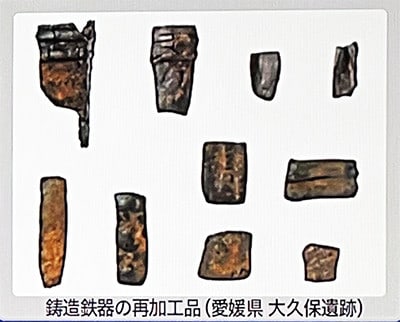



以下は、島根県雲南市の「海を渡ってきた「鉄」の話」より要旨。
〜世界で初めて鉄が作られたのは3800~4000年前の西アジアが有力。
一方中国で鉄が作られたのは3400年前ごろ。日本はまだ縄文時代の後期後半。
中国でも鉄の始まりは宇宙からの落下隕鉄(鉄隕石)を利用したという。
このころ中国ではすでに鋳銅技術が開発され金属器といえば青銅器が主流。
鉄はとても貴重なものだった。やがて中国では世界に先がけて銑鉄が作られ
この銑鉄を鋳型に流し込んだ鋳造鉄器とよばれる鋳物鉄製品が作られた。
この銑鉄は鉄中に炭素を多く含むので非常に硬い半面、衝撃には脆い性質があり、
刃物などの利器には適さなかった。しかし鉄中の炭素を減じる技術が開発され、
粘りのある鉄が鋳造鉄器刃部に利用されるようになった。
日本の弥生時代中期ごろには鉄製の鉄斧破片などが北部九州日本に運ばれ、
再利用された。石道具で山野開拓した弥生人は鉄器の切れ味の威力に驚いた。
持ち込まれた鉄製品は超貴重品だった。
やがて中国製鉄技術は朝鮮半島の北部に伝播。そして3世紀ごろ、
朝鮮半島南部で生産の鉄が日本に輸入。弥生時代後期後半から古墳時代初め。〜

まさに現代世界にも共通する産業技術革命そのものですね。
青銅の技術はすでに伝わって、銅鐸などが威信材として導入されていたけれど、
鉄の驚くべき性能ぶりが一気に世を変えていったことが想像できる。
弥生の社会にこの鉄器が導入され土地開発農具として最高の存在になった。
開墾器具にも木を切る斧の先端素材としても、それまでの効率・仕上がりを
はるかに凌駕し労働の時間短縮・精度向上を実現したことは想像に難くない。
たぶんそれは同時に戦争の「武器」としても活用されていったに相違ない。
戦いをすれば、鉄を持つ集団は圧倒的な強さを発揮できたのだろう。
争うように鉄の獲得戦が行われることも自然な成り行き。
ほぼ信仰にも似た鉄器への希求が社会の基底で盛り上がっていった。
日本国家生成の時期、朝鮮半島国家群との強い国際関係が基本で
揺籃期の日本権力機構で決定的要素だったのには、
この鉄器の生産と導入が死活的だった事情を表しているのだろう。
やがて白村江海戦という東アジア世界大戦に突っ込んでいく動機は
このことが社会経済の存亡に直結したからなのだろう。
白村江敗戦のあとでようやく鉄は国内生産が可能になっていくことで
日本列島社会は東アジア世界との強い関係性からやや脱することができる。
経済的自立が国の安定の決定的要因なのは、いつの時代も不変。
弥生から国家形成の時期にかけて、日本社会ではこういう切羽詰まった事情が
鉄を巡って存在していただろうことが可視化されてきている。
English version⬇
Iron, the Core Material of Agriculture: A Nation? The 37,000-Year History of the Japanese Archipelago - 35
Why did Japan in the Tenchi period fight the reckless Battle of Hakuchon River? The situation of acquiring "iron" resources in a desperate situation. ...
The following is an abstract from "The Story of 'Iron' Across the Sea" in Unnan, Shimane Prefecture.
〜The first time iron was made in the world is believed to have been in Western Asia between 3,800 and 4,000 years ago.
In China, on the other hand, iron was first produced around 3,400 years ago. Japan is still in the latter half of the Jomon Period.
In China, too, iron was first made from meteoric iron (iron meteorites) that fell from outer space.
At this time, bronze casting technology had already been developed in China, and bronze vessels were the main type of metalware.
Iron was very precious. Eventually, China became the first country in the world to produce pig iron, and this pig iron was then used in casting molds.
This pig iron was poured into molds to produce cast ironware.
Pig iron is extremely hard due to the high carbon content in the iron, but it is also brittle upon impact.
It was not suitable for use as a cutting tool or other useful tool. However, in China, a technology was developed to reduce the amount of carbon in the iron.
The technique to reduce the amount of carbon in iron was developed in China, and iron with a high tenacity came to be used for cast-iron blades.
In the mid-Yayoi period in Japan, iron axe shards made of iron were transported to northern Kyushu Japan and reused.
They were reused. The Yayoi, who cultivated the mountains and fields with stone tools, were amazed at the power of the sharpness of iron tools.
The iron products they brought with them were highly prized.
Eventually, Chinese iron manufacturing technology spread to the northern part of the Korean Peninsula. Around the 3rd century, iron products produced in the southern part of the Korean peninsula were introduced to the Yayoi people.
Iron produced in the southern part of the Korean Peninsula was imported to Japan. Late Yayoi Period to early Kofun Period. 〜From the late Yayoi Period to the early Kofun Period
It is the very industrial and technological revolution that is also common in the modern world.
Bronze technology had already been introduced, and bronze bells and other objects had been introduced as prestige materials, but the amazing performance of iron was changing the world at a stroke.
We can imagine that the amazing performance of iron changed the world at once.
The introduction of iron tools into Yayoi society made them the best tools for land development and agriculture.
Whether used as cultivation tools or as the cutting edge of an axe, iron tools far surpassed the efficiency and workmanship of previous tools.
It is not difficult to imagine that the iron tools were far more efficient and effective than the conventional tools, shortening labor time and improving accuracy.
It was probably also used as a "weapon" in warfare.
In a battle, a group with iron would have been overwhelmingly strong.
It was natural that they would fight to acquire iron.
The desire for iron tools, which was almost like a religious belief, rose at the base of society.
During the period of the birth of the Japanese state, strong international relations with the Korean Peninsula states were fundamental.
The production and introduction of ironware was a decisive factor in Japan's power structure in its infancy.
The production and introduction of ironware was a critical factor in the development of Japan's power structure.
The motivation for the Japanese to eventually plunge into the Battle of Hakuchonjiang, a world war in East Asia, was directly related to this.
The reason why the Japanese were eventually driven into the East Asian World War, the Battle of the White River, may be because of the direct link between this war and the survival of the social economy.
After the defeat at the Hakuchon River, domestic production of iron finally became possible, and the Japanese archipelago's society was able to survive in the East Asian world.
Japanese society could somewhat break away from its strong relationship with the East Asian world.
Economic independence has always been a decisive factor for national stability.
From the Yayoi period to the period of state formation, this kind of impasse would have existed in Japanese society
It is becoming visible that this kind of desperate situation would have existed around iron in Japanese society from the Yayoi period to the period of state formation.



















